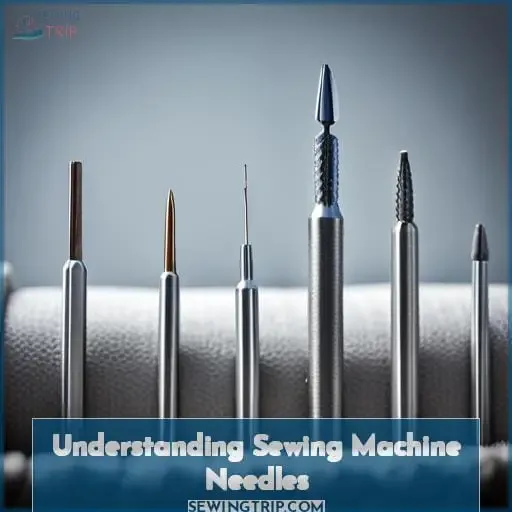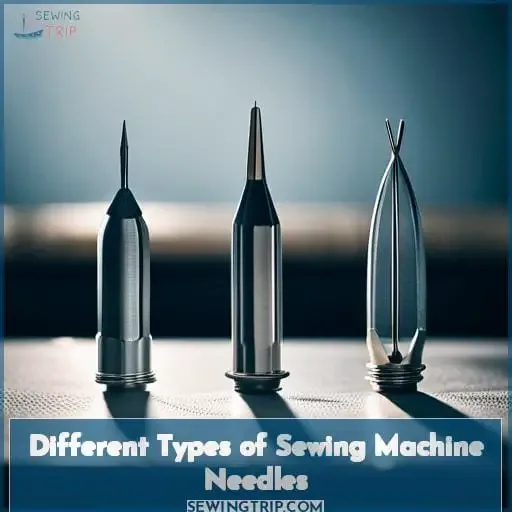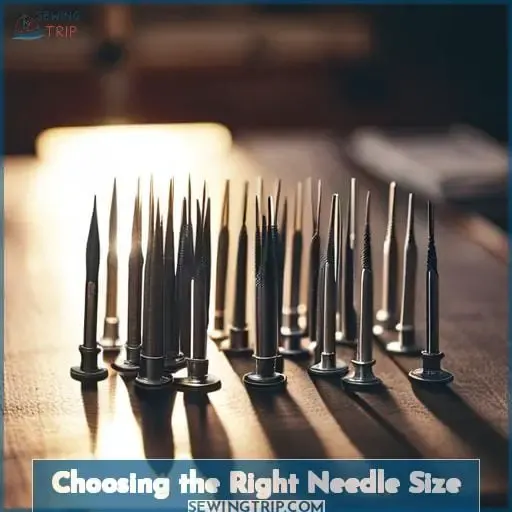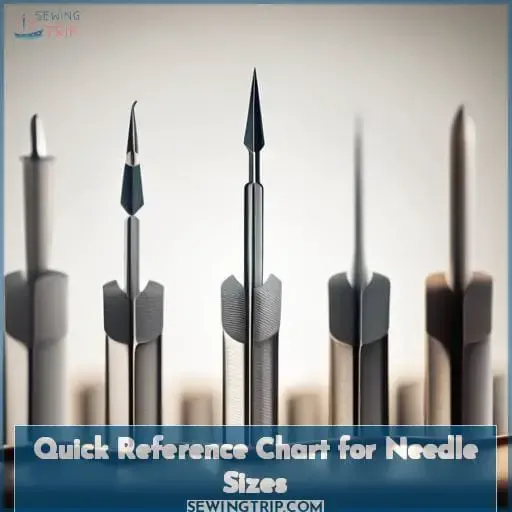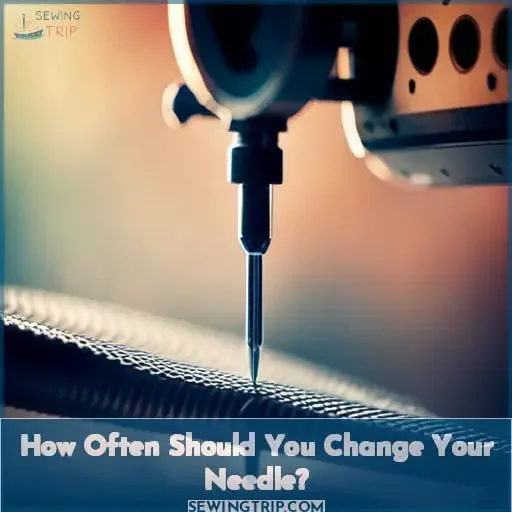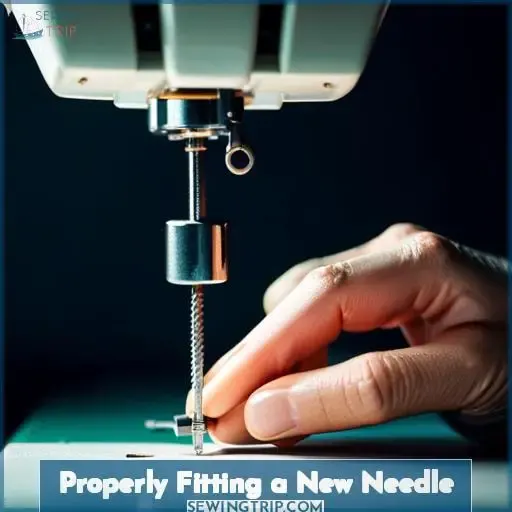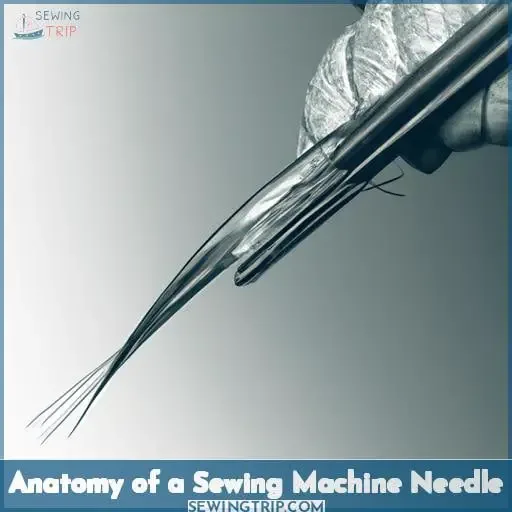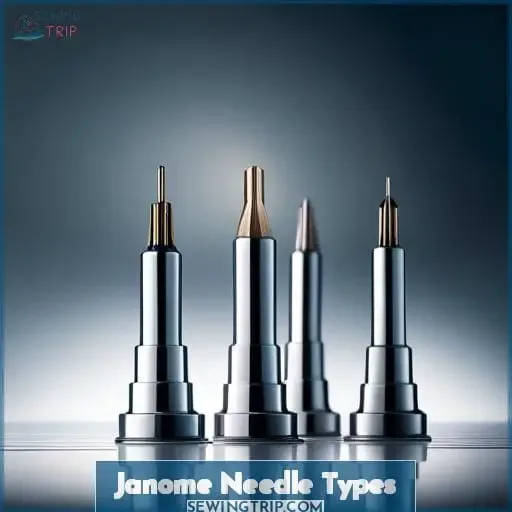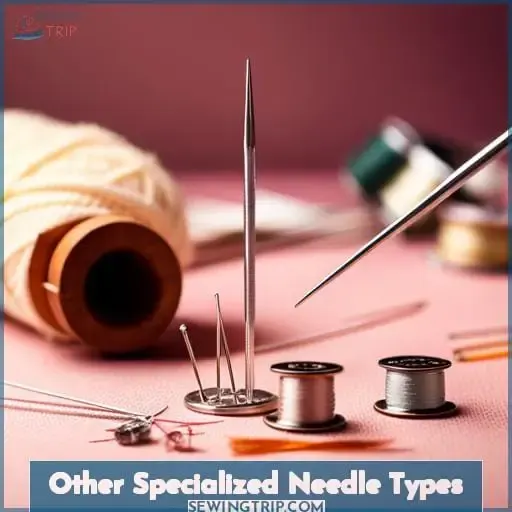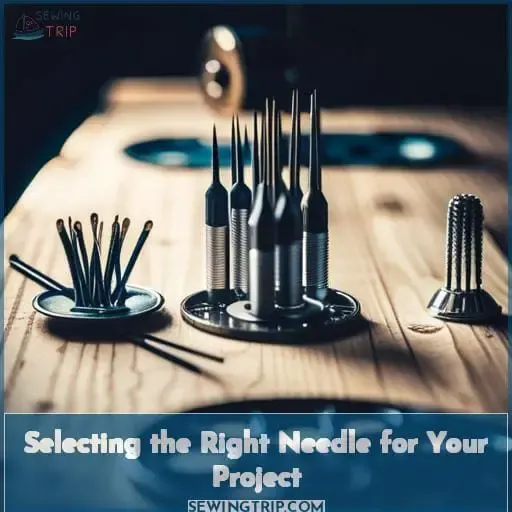This site is supported by our readers. We may earn a commission, at no cost to you, if you purchase through links.
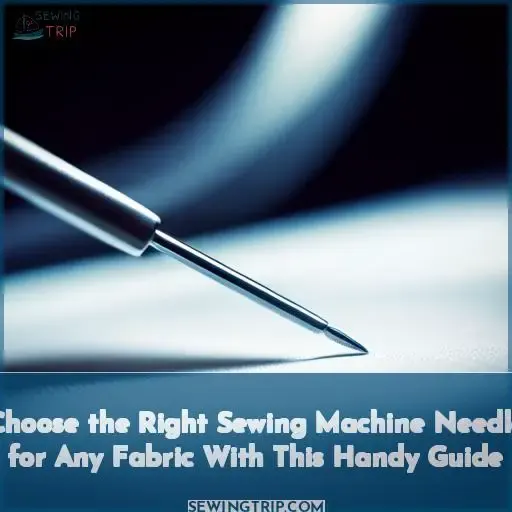 I bet you thought sewing was as easy as picking a needle and thread, right? Think again, friend. Choosing the wrong sewing machine needle can wreak havoc on your machine, fabric, and sanity. But don’t worry – with some handy tips from yours truly, you’ll be matching needles and fabrics like a pro in no time.
I bet you thought sewing was as easy as picking a needle and thread, right? Think again, friend. Choosing the wrong sewing machine needle can wreak havoc on your machine, fabric, and sanity. But don’t worry – with some handy tips from yours truly, you’ll be matching needles and fabrics like a pro in no time.
The key is understanding the different types of needles and which ones pair best with your project. We’ll cover the basics – like universal and ballpoint needles – along with more specialized options for stretchy or delicate materials.
I’ll even throw in a quick reference chart, so you can get sewing with confidence.
After all, the right sewing machine needle makes all the difference between stitching success and total frustration.
Table Of Contents
- Key Takeaways
- Understanding Sewing Machine Needles
- Different Types of Sewing Machine Needles
- Choosing the Right Needle Size
- Quick Reference Chart for Needle Sizes
- How Often Should You Change Your Needle?
- Properly Fitting a New Needle
- Anatomy of a Sewing Machine Needle
- Janome Needle Types
- Other Specialized Needle Types
- Selecting the Right Needle for Your Project
- Frequently Asked Questions (FAQs)
- Conclusion
Key Takeaways
- Universal, ballpoint, stretch, sharp, jeans, and leather needles are available for different types of fabrics.
- Needle sizes range from finer needles for lightweight fabrics to thicker needles for heavier fabrics.
- Needle tips have flat sides, oval eyes, and smooth shoulders for a better sewing experience.
- Specialty needles like blue tip, purple tip, red tip, twins, and wing needles are available for specific sewing needs.
Understanding Sewing Machine Needles
You’ll want to match up the needle type and size to your fabric’s weight and fiber content for smooth sewing.
Start by selecting the needle type – universal, ballpoint, jeans, leather, embroidery, etc based on your project’s fabric. Then choose the right size – a lighter weight fabric takes a finer needle like size 80/12 while heavier wovens need a size 90/14 or 100/16.
You can’t go wrong with quality needles from Schmetz or Organ as they offer a full range of needle types and sizes.
Be sure to change the needle regularly and buy multiple packages so you always have a fresh needle on hand when the current one starts getting dull.
Following these simple tips will have you sewing with ease.
Different Types of Sewing Machine Needles
Choosing the right needle for your fabric is crucial! Using a universal needle is a good place to start for wovens and some knits, but you’ll get better results by picking a needle designed for your project.
Ballpoint needles glide smoothly over knits without snagging the loops. Stretch needles have a special scarf to sew knit fabrics with spandex and prevent skipped stitches. Moving to woven fabrics, sharp needles are ideal for quilting, silk, microfibers, and other fine fabrics that require precision.
Quilting needles have a shorter shaft than sharps to make sure your stitching stays flat and even.
Universal Needles
A person can expect the most common Schmetz Universal needles to fit about 75% of basic home sewing projects because these smooth and versatile needles stitch both woven and synthetic fabrics well with polyester or poly/cotton threads.
- Size 75/11: Lightweight wovens, cottons
- Size 90/14: Common for general use
- Size 100/16: Medium weight wovens
- Size 110/18: Heavy wovens like denim
- Size 120/19: Very heavy wovens, small leather
Schmetz Universal needles handle the widest variety of fabrics and techniques. Using the proper size prevents skipped stitches, puckering, and jagged seams for smooth sewing and neat projects.
Ball Point Needles
You need ballpoint needles for knits because they prevent runs in stretchy fabrics. Their rounded tips slide between knit fibers instead of piercing them. Ballpoints keep stitches smooth on neckbands, cuffs, and curved seams.
Stretch Needles
Stretch needles slide smoothly through elastic fabrics to prevent skipped stitches.
They help with fabrics like:
- Spandex
- Lycra
- Knits
- Swimwear
- Activewear
These specialty needles have a rounded tip and scarf to glide between the fibers. Their flexible shaft won’t damage delicate knits. For best results, use stretch needles on low to medium settings. Polyester or cotton/poly threads work well. Follow any stretch stitch recommendations in your sewing machine manual.
Sharps Needles
Crafting with precision, seize these needles for sharper stitching through delicate fabrics. Sharps outline stitches against backgrounds. Sharps embroider flowers and leaves. For hi-low pile, sharps define chenille’s texture. Sharp needles master light fabrics and fine threads.
Quilting Needles
Shorter than sharps, quilting needles evenly stitch layers. Pick size 80/12 or 90/14 for piecing. Use topstitch needles for thicker battings. Red tip for general use, blue for hand-guided.
Choosing the Right Needle Size
You’ve picked up your fabric, so now which size needle should you grab? What fits this weight and weave without damaging the material or frustrating me as the sewer? is the question to ponder before selecting the proper needle gauge for your next sewing project.
- Universal size 80/12 for lightweight wovens.
- Size 90/14 for medium weight cottons and polyesters.
- Size 100/16 for denim and canvas.
- Size 110/18 or 120/19 for upholstery and outdoor gear.
Sewing enthusiasts, choosing the correct needle size prevents issues like skipped stitches from too thin a shaft, fabric damage from too thick, and thread shredding from fabrics and threads mismatched.
Pick the size matching your fabric weight and weave. A needle that is too small bends and shreds thread. Too large leaves holes. Like Goldilocks, find the one that’s just right. Test an inconspicuous spot first before sewing your project.
Quick Reference Chart for Needle Sizes
You’d best keep a quick reference chart for recommended needle sizes handy while sewing different fabrics.
| Fabric | Needle Size | Needle Type |
|---|---|---|
| Lightweight woven | 70/10 – 80/12 | Sharp, ballpoint |
| Medium woven | 80/12 – 90/14 | Sharp, ballpoint |
| Denim, canvas | 90/14 – 110/18 | Denim, sharp |
| Knits | 75/11 – 90/14 | Ballpoint, stretch |
| Microfibers, silk | 60/8 – 70/10 | Sharp, ballpoint |
| Leather, suede | 90/14 – 110/18 | Leather, cutting |
Having the right needle for your project prevents skipped stitches, puckering, and snagging. Ballpoint tips glide between knit fibers without spearing them. Thicker shafts withstand dense fabrics without bending.
Sharps pierce tightly woven cloth cleanly. With the proper needle, you’ll achieve smooth, professional results.
How Often Should You Change Your Needle?
You oughta swap needles as often as you change your socks to keep your machine humming smoothly. After finishing any decent-sized project, it’s smart to toss the needle and insert a fresh new one.
Here’s why:
- Needles dull over time and repeated piercing. This leads to potential skipped stitches, thread shredding, or needle breakage.
- Fabrics and threads slowly degrade needle tips. Using worn needles risks damaging your fabric by pulling, snagging, or creating runs.
- Clean, sharp needles sew smoothly and make nice, even stitches. Dull, burred needles make messy stitches.
Test your needles often by sewing on scrap fabric. Make sure to insert correctly and tighten fully.
Following these simple tips keeps your machine sewing like a dream and projects looking crisp.
Properly Fitting a New Needle
When inserting a new needle, slide it upwards with the flat side facing backwards until it’s fully seated for proper fitting.
The point size must match your fabric weight to prevent skipped stitches. Thicker shafts pierce denser fabrics while thinner ones suit delicates.
The scarf guides thread close to the eye for smooth stitch formation. Avoid overheating needles, which compromises strength.
Oval or elongated eyes accommodate thicker threads like topstitching. Examine for burrs around the eye, which shred thread.
A properly fitted needle is pivotal for beautiful seams and even stitch length. Master needle selection, and your sewing will reflect mastery.
Anatomy of a Sewing Machine Needle
Now that you’re familiar with properly fitting a new needle, let’s dive into the anatomy of a sewing machine needle. Understanding the different parts of a needle will help you select the right one for your project.
The main parts of a sewing needle are:
- Eye – The hole at the top of the needle where the thread passes through. The shape and size impact shredding.
- Shaft – The long body of the needle. The thickness affects which fabrics it can sew.
- Point – The very tip of the needle that punctures the fabric. It varies from ballpoint to sharp.
- Scarf – The groove above the eye that provides clearance for the hook to pick up the thread.
- Shank – Where the needle attaches to the sewing machine. It must be fully inserted.
With this overview of the key components, you can better evaluate needle selection for your fabric. Referencing needle anatomy diagrams and sizing charts will guide your size and style choices. Test new needles and fabrics first before sewing your project. Having the right needle makes all the difference in smooth sewing and preventing issues.
Janome Needle Types
Let’s discuss the different Janome needle types. It’s important to pay attention to the colored tips on Janome needles, as they indicate their intended use. Janome Blue Tip needles are designed for general sewing on medium-weight wovens and knits.
For stretchy fabrics like knits and spandex, you should use the Janome Purple Tip needle. And when sewing on heavy denim or canvas, opt for the Janome Red Tip needle to power through the thick layers.
Knowing which colored tip needle to use for your project will result in smooth, frustration-free sewing.
Janome Blue Tip Needles
Blue tips indicate Janome’s universal needles for woven fabrics and some knits. They work well on most common fabrics like cotton, linen, and rayon. Use blue tips to avoid needling and thread fraying. Size 80/12 blue tip handles lightweight wovens.
Size 90/14 is for midweight. Larger sizes are for heavier wovens and pile fabrics. The blue tip guides the eye during insertion and prevents shredding of metallic threads.
Janome Purple Tip Needles
You’ll love Janome’s purple tip needles for easy sewing on stretchy fabrics like spandex and Lycra. Their sharp point glides smoothly through the knit stitches without chafing or damage. The scarf prevents skipped stitches, a common issue with metallic threads shredding.
For twin needle hemming knits or decorative topstitching, Janome’s purple needles handle the job with precision. Different fabrics need different needles, so pick purple for silky knits and stretch fabrics.
Janome Red Tip Needles
You can use a fiery red tip needle when working with natural fibers like linen, cotton, silk, and wool. These needles have a sharp point to easily pierce the fibers. Try different needles on fabric swatches first to find the perfect match.
Replace dull needles for optimal performance. Make sure to use the recommended threads for durability and smooth stitching.
Other Specialized Needle Types
Don’tcha know it, twin and wing needles’ll give your stitches some flare. From intricate embroidery to decorative topstitching, specialized needles open up new possibilities.
Twins neatly stitch two parallel lines at once – handy for pintucks or decorative accents on napkins and clothing.
Wing needles punch oval holes in fabric – use ’em to get drawn thread or hemstitch effects.
Metallic threads need big eyes and smooth shoulders – try metafil needles so those glimmering golds and silvers make it through without shredding.
And don’t forget topstitching needles for bolder stitches that stand out. Their extra sharp points and large eyes handle thicker threads and fabrics with ease.
What will you create today? With the right needles, your machine can handle almost any technique.
Selecting the Right Needle for Your Project
Experimenting with different needle types and sizes on fabric swatches helps you find the perfect match before starting your next sewing project.
- Test needle sizes 80/12, 90/14, and 100/16 on the swatch.
- Listen for crunching and feel for skipped stitches.
- Check the stitch appearance and spacing.
- Try universal, stretch, and jeans needles on knits, wovens, and denim.
- Use thick needles on thick fabric and finer needles on lightweight fabric.
The key is matching the needle to the thread and fabric weight. Quilting projects need sharper points for precision stitching, while ballpoint tips prevent snagging knits better than universal needle tips.
Size up needle thickness for heavier woven fabrics or with thicker threads. Finding the right balance takes testing, but proper needle selection prevents headaches and improves your sewing machine’s performance.
Frequently Asked Questions (FAQs)
What are the best needle brands for home sewing machines?
You can’t go wrong with Schmetz or Organ needles. Their universal and specialty needles suit most fabrics and techniques. Your machine will thank you for choosing quality, precision-engineered needles that prevent skipped stitches, puckering, and fraying.
Where can I buy sewing machine needles locally?
Don’t you wish it was easy to find the right needles? Look no further than your local craft, fabric, or sewing machine specialty store. These shops stock top brands like Schmetz and Organ, and knowledgeable staff can help match needles to your fabrics, techniques, and machine model.
How do I know if my needle is dull or damaged?
You can tell a needle is dull or damaged if your fabric is shredding or your stitches are skipping. Run your finger gently along the needle – if it feels rough instead of smooth, replace it. Inspect the eye and point for burrs or nicks too. Trust your senses while sewing to know when a fresh needle is needed.
Can I use a twin needle in my sewing machine?
Yes, you can use a twin needle in most sewing machines. Just insert it the same way as a regular needle, with the flat side facing the back. Make sure your machine can sew with two threads simultaneously. Check the manual for the maximum width and stitch length.
How do I safely dispose of used and broken needles?
You there! Handle those pointy needles carefully. Don’t just toss them willy-nilly into the trash where they’ll stab some poor sanitation worker. Instead, store used and broken needles in a sealed container like an empty detergent bottle before disposing.
Conclusion
Let’s sew this up! Picking the right needle for your fabric is crucial to get the job done. With the handy needle guide and sizing chart as your trusty thimbles, you’ll be stitching success in a jiffy.
Whether it’s stretchy knits or heavyweight denim, find your perfect needle match.
Inserting needles properly avoids tangles and breaks. Follow the anatomy of the eye, shaft, and point to aim true. With the proper sewing machine needle to use, your projects will fly off the machine smooth as silk.
Happy sewing!

